How To Group Debtors And Accounts
In collections, it is a common inventory management strategy to utilize account grouping to centralize
multiple debts pertaining to single debtors. A debtor for grouping consideration may be a single
individual, family members, spouse accounts, corporate accounts with the same owner, etc. Grouping
optimizes a collector's efficiency because they have access to a consolidated Group Tab which provides
summary details and grand totals for all accounts in the Group. Additionally, they are easily able
to toggle between individual accounts within the Group for exact details on a per debt basis.
In Collect!, accounts are Grouped by automated processes according to preset criteria and preferences
in your Account Matching Setup window and/or by manually joining a select number of accounts.
Account Matching Setup Form
Click Here to View this Form.
Click Here to Close this Form.
Account matching automatically detects matching
accounts and groups these accounts together.
The Account Matching Setup form stores default settings
for Collect! to use when matching accounts. These settings
determine how Collect! looks for matches and what it does
if it finds them.

Account Matching Setup Window
Account matching handles two basic conditions - first,
when new accounts are entered, and second, when existing
accounts are grouped together arbitrarily.
When entering new accounts, Collect! checks for matching
entries such as name, or social security number. When you
exit from a field after typing something, Collect! checks if
there's another account with a matching or close value. If there
is, it displays a list and lets you choose one.
 When adding accounts to an existing group, the
current settings in the Account Matching Setup
window are set on added accounts. When creating new
group, the current settings are set on all accounts.
When adding accounts to an existing group, the
current settings in the Account Matching Setup
window are set on added accounts. When creating new
group, the current settings are set on all accounts.
Accessing Account Matching Setup
The Account Matching Setup window may be accessed in
multiple ways. Provided your User Level provides the software
access, you can use one of the following ways to get to the
Account Matching Setup:
- Using the menu bar at the top of your screen, click
"System\Preferences\Plans and Reference Tables\Account
Matching Setup".
- From the Main Menu, click the "System Administration"
button on the left of the window, then click "Setup and
Configuration" button. This will take you to the same
menu options as above. Click "Plans and Reference Tables\Account
Matching Criteria" to complete the navigation to the
same destination as in #1 above.

Options
This section contains account matching
options. The selections are explained below.

Enable Account Matching
This switch turns on the account matching
feature. When you turn the switch off,
account matching is disabled.

Disable Account Matching
You can enable or disable account matching
using the 'Enable account matching' check box.

Prompt Before Cascading Changes
Turn ON the Prompt before Cascading Changes
switch with a check mark to receive a prompt
to verify before copying data.
It is important to switch this ON if you
have any doubts about the data you may
be copying.

Prevent Cascade When Closed
Switch this ON with a check mark to prevent
cascading of data to group members where the
account has a Closed Mode. Collect! will still
show matching records if the account is closed,
but it will not cascade any data or changes to
closed accounts. This switch is in the Group
Member Setup form as well.

Cascade Phone Deletions
Switch this ON with a check mark to cascade
phone deletions. With this switch ON, you can
delete a phone number for one group member
and Collect! will delete the number from the
other group members, as well.
Any phone number deleted by this process will be
logged to the Debtor's Notes.

Prompt On Phone Deletes
Switch this ON with a check mark to alert
the user before cascading phone deletions.
If this switch is ON, the user will be
warned only when a phone number is about
to be lost due to a blank cascading across
the group. This prompt will only occur
once per set of group members. If the
user selects NO, blanks will not cascade
across, otherwise they will.
Any phone number deleted by this process
will be logged to the Debtor's Notes.
This switch is visible only when "Cascade
phone deletions" is switched ON.

Manage Group Promises
Switch ON 'Manage group promises' to
have Collect! manage promised payments for group
members. Collect! will advance the debtor's
Promise date when the promise is met. Specified
contact plans for full payment, underpayment,
overpayment, NSF payment and broken payment
conditions are called when necessary. The
payment can be posted to any group member and
Collect! will find the next qualifying promise
contact in the group to manage.
When this switch is ON and a payment is posted,
Collect! automatically fills in Promise details
based on the Promise contact's promised Amount
and the setting for Transaction Type in the
Payment Values form.
For this feature to work, 'Automatically manage
promises' on the Payment Posting Options form
must be set to ON.
 If this feature is enabled, when an
account's balance reaches $0.00, then
the Promise Contact will move to the
next Group Member with the highest balance.
If this feature is enabled, when an
account's balance reaches $0.00, then
the Promise Contact will move to the
next Group Member with the highest balance.

Prompt To Run Plan On Group
Switch this ON with a check mark to to enable
run plans on groups from the RUN PLAN field
and ACTION button on the debtor form. When
enabled, if you run a contact plan on the debtor,
and you are on a group, Collect! will prompt you
asking if you want to run the contact plan on
the entire group or just the current member.

Share Notes By Default
Switch ON 'Share notes by default' to display
the 'Share Notes' tab on the Debtor by default.
The 'Share Notes' tab displays all the notes
from all group members in a single tab. The
notes in this tab are read only and cannot
be edited.

Full SSN Wildcard
Switch ON 'Full SSN Wildcard' to search the
entire SSN for the partial match when using
the * character. When off, only the last 4 of
the SSN are used for the partial search.

Check And Prompt On Near Matches
Check and Prompt on Near Matches controls
which fields are automatically checked for
matching debtors as you enter information.
You will be prompted when near matches are
found. The settings are explained below.

Match Name
Enabling this switch invokes an attempt to
try to match newly entered or newly edited
accounts based on information in the Name
field.

Match Contact
Enabling this switch invokes an attempt to
try to match newly entered or newly edited
accounts based on information in the Contact
field.

Match Phones
Enabling this switch invokes an attempt to
try to match newly entered or newly edited
accounts based on information in any of the
phone fields.

Match SSN
Enabling this switch invokes an attempt to
try to match newly entered or newly edited
accounts based on information in the SSN
field.

Match DOB
Enabling this switch invokes an attempt to
try to match newly entered or newly edited
accounts based on information in the DOB
field.

Match DL
Enabling this switch invokes an attempt to
try to match newly entered or newly edited
accounts based on information in the DL field.

Match Email
Enabling this switch invokes an attempt to
try to match newly entered or newly edited
accounts based on information in the email field.

Match Acct
Enabling this switch invokes an attempt to
try to match newly entered or newly edited
accounts based on information in the acct field.

Copy When Creating
The Copy When Creating New Records controls
whether or not you will copy a particular
field's information FROM the EXISTING account
TO the NEW account being entered. This will
save you time, should the information be
identical.
Data in the new debtor will be overwritten
by the data in the matching existing account.
If you do not want to risk losing possibly
newer information or previously unknown trace
leads if a prior demographic is unknown on
existing accounts, then DO NOT use this feature.
The options below control which fields you
have overwrite ability FROM and EXISTING account
TO a NEW account being entered:

Copy Name
When this switch is ON, the process will copy
the information in the Name field to a newly
entered account from the original account,
if there is a match.

Copy Contact
When this switch is ON, the process will copy
the information in the Contact field to a newly
entered account from the original account,
if there is a match.

Copy Phones
When this switch is ON, the process will copy
the information in all phone fields to a newly
entered account from the original account,
if there is a match.

Copy SSN
When this switch is ON, the process will copy
the information in the SSN field to a newly
entered account from the original account,
if there is a match.

Copy DOB
When this switch is ON, the process will copy
the information in the DOB field to a newly
entered account from the original account,
if there is a match.

Copy DL
When this switch is ON, the process will copy
the information in the DL field to a newly
entered account from the original account,
if there is a match.

Copy Address
When this switch is ON, the process will copy
the information in the address fields to a newly
entered account from the original account,
if there is a match.

Copy POE
When this switch is ON, the process will copy
the information in the POE field to a newly
entered account from the original account,
if there is a match.

Copy Email
When this switch is ON, the process will copy
the information in the email field to a newly
entered account from the original account,
if there is a match.

Cascade Data To Other
The Cascade Data to Other Group Members
controls how the accounts in a group are
synchronized with respect to shared fields
when an update takes place on ONE account
in the group.
We recommend caution with this feature: it
does overwrite information in the target fields
once an update has been initiated on any
account in the group.
A popular switch pairing is the use of Cascade
along with the Options switch to "Prevent
cascade when closed".
Each group member has its own cascade settings
located inside the Group Tab, Group Member
Setup. It is possible to fine-tune the settings
ad hoc on a per group basis if the need arises.
Additionally, you can modify the settings to
be different on select members within a group
such that some group members remain independent
and/or unaffected by updates.
The choices to control cascading data are
explained below:

Cascade Name
When this switch is ON, the feature will
cascade any edits entered into the Name field
across all matching accounts.

Cascade Contact
When this switch is ON, the feature will
cascade any edits entered into the Contact field
across all matching accounts.

Cascade Phones
When this switch is ON, the feature will
cascade any edits entered into any phone fields
across all matching accounts.
If you want to cascade deleting phone numbers,
you must switch ON "Cascade phone deletions."

Cascade SSN
When this switch is ON, the feature will
cascade any edits entered in the SSN field
across all matching accounts.

Cascade DOB
When this switch is ON, the feature will
cascade any edits entered into the DOB field
across all matching accounts.

Cascade DL
When this switch is ON, the feature will
cascade any edits entered in the DL field
across all matching accounts.

Cascade Address
When this switch is ON, the feature will
cascade any edits entered in the address
fields across all matching accounts.

Cascade POE
When this switch is ON, the feature will
cascade any edits entered in the POE field
across all matching accounts.

Cascade Email
When this switch is ON, the feature will
cascade any edits entered in the email field
across all matching accounts.

Cascade Worked
When this switch is ON, the feature will
cascade the Worked Date of an account across
all matching accounts.
The Worked Date on grouped accounts is
always kept up-to-date on all group members,
and is shown in red if someone worked the
account already today. In this way, you can be
sure you won't be calling the same account in
one day.

Cascade Status
When this switch is ON, the feature will
cascade changes of the Status Code of an
account across all matching accounts.
If your site uses statuses such as PIF,
SIF, DIS etc., you may wish to leave
this switch OFF to prevent an accidental
sweep of a status code that was meant
for a single account inside the group.

Cascade Notes
When this switch is ON, the feature will
cascade notes to other members in the
established group, provided the 'Cascade
notes' switch is also activated within the
Group Tab of the individual debtor accounts.
Visit the Collect! Member Center for a utility
report to assist with mass updating of the
"Cascade notes" and "Share notes" switches
in pre-existing groups. Choose the drop-down
menu Add-Ons, then the category "Utility Reports
and Snippets" from the body of the page. If
you are logged into the Member Center, the
zip called "Group Notes - Cascading and Share
Notes Tab". The zip file contains a write back
report that will optimize your ability to activate
the new fields. To utilize the report, import the
.rpt file into your system and follow the
directions which come with the report zip file.
Cascade notes may be further controlled for
each individual site by the 'Prevent cascade
when closed' and 'Prompt before cascading
changes' switches in the Options area of the
Account Matching Setup window.

Advanced Match Conditions
This section is where you define the criteria
that will be used to determine which fields
in combination of Boolean AND/OR conditions
will be used to decision whether a new account
entering the system will be deemed a match to
one or more accounts currently existing in your
database. Criteria for the match conditions
are chosen from the pick lists on the fields.
Press F1 for additional details when your
cursor is within this input entry area.

Commit
Select this button to commit your changes.
In progress.

OK
Selecting this button will save any data
you have entered and return you to the
previous form.

Cancel
Select this button to ignore any changes
you may have made and then return to the
previous form.

Help
Select this for help on the Account
Matching Setup window and links to related
auto-grouping topics.

Ensure you have filled out your global preferences and criteria in "System\Preferences\Plans and
Reference Tables\ Account Matching Setup" before attempting to launch an automated grouping process.
This Setup will contain all the behaviors and field comparisons you wish to base your grouping
strength on. Collect! ships with some of the most common settings preset for you, however, these
should be reviewed by each site before going live to ensure any specific and/or unique requirements
are being addressed in the settings.
The automated processes compare new accounts entering your database and compares them to pre-existing
inventory as a function of the "Check" preferences when individual accounts are being manually data
entered and to the field combinations selected in the "Advanced Match Conditions" when it is a volume
of accounts being processed in batch.
 If you change your Account Matching settings at any time, these will be go forward changes
and will not retroactively affect Member Setups within existing debtors already in groups.
If you make a change that needs to be retroactively updated to existing Group Members,
please contact Technical Services for a consult on how to best achieve your result with the
least amount of manual manipulation. A small, custom utility Write backs will likely be all
that you require.
If you change your Account Matching settings at any time, these will be go forward changes
and will not retroactively affect Member Setups within existing debtors already in groups.
If you make a change that needs to be retroactively updated to existing Group Members,
please contact Technical Services for a consult on how to best achieve your result with the
least amount of manual manipulation. A small, custom utility Write backs will likely be all
that you require.

Using Account Matching
There are several reasons for grouping debtors:
- You may realize that several of your accounts are related and you may wish to view them
together.
- You might have one outstanding debt, such as a funeral home bill, with several debtors who
could be responsible to settle the account.
- You may have several debtors who belong to the same Client, or share some other type of
information that you want to keep together.
- You may have a group of debtors setup already and you may get a new debtor that you want to
add to the group.
In any of these cases, and others, Collect! allows you to link these accounts together.
There are three ways by which accounts can become successfully matched to existing inventory:

Account Matching During Data Entry
For this capability to function, you must have checked one or more of the switches under the category
"Check" in preferences already entered into your "System\Preferences\Plans and Reference Tables\
Account Matching Setup" window.
 WARNING: The Check feature of account matching looks for any 'near' matches to provide a wide
margin of possibilities. You may wish to streamline your entry and allow only reliable
matches under Batch Processing, leaving the "Check and prompt on near matches" area of
Setup blank. This will prevent your employees from being inundated with irrelevant data
and mitigate grouping errors as the system in batch mode will ONLY consider the
conditional criteria in your Setup being exact matches, not near matches.
WARNING: The Check feature of account matching looks for any 'near' matches to provide a wide
margin of possibilities. You may wish to streamline your entry and allow only reliable
matches under Batch Processing, leaving the "Check and prompt on near matches" area of
Setup blank. This will prevent your employees from being inundated with irrelevant data
and mitigate grouping errors as the system in batch mode will ONLY consider the
conditional criteria in your Setup being exact matches, not near matches.
If you are using Check settings, then when an Operator is manually data entering accounts, they will
be presented with a popup list of " Matching Accounts" as they press Tab or Enter to navigate to the
next field. The Operator will be presented with a single line of fields from one or more existing
accounts to compare and decision if the new account seems to be the same debtor.
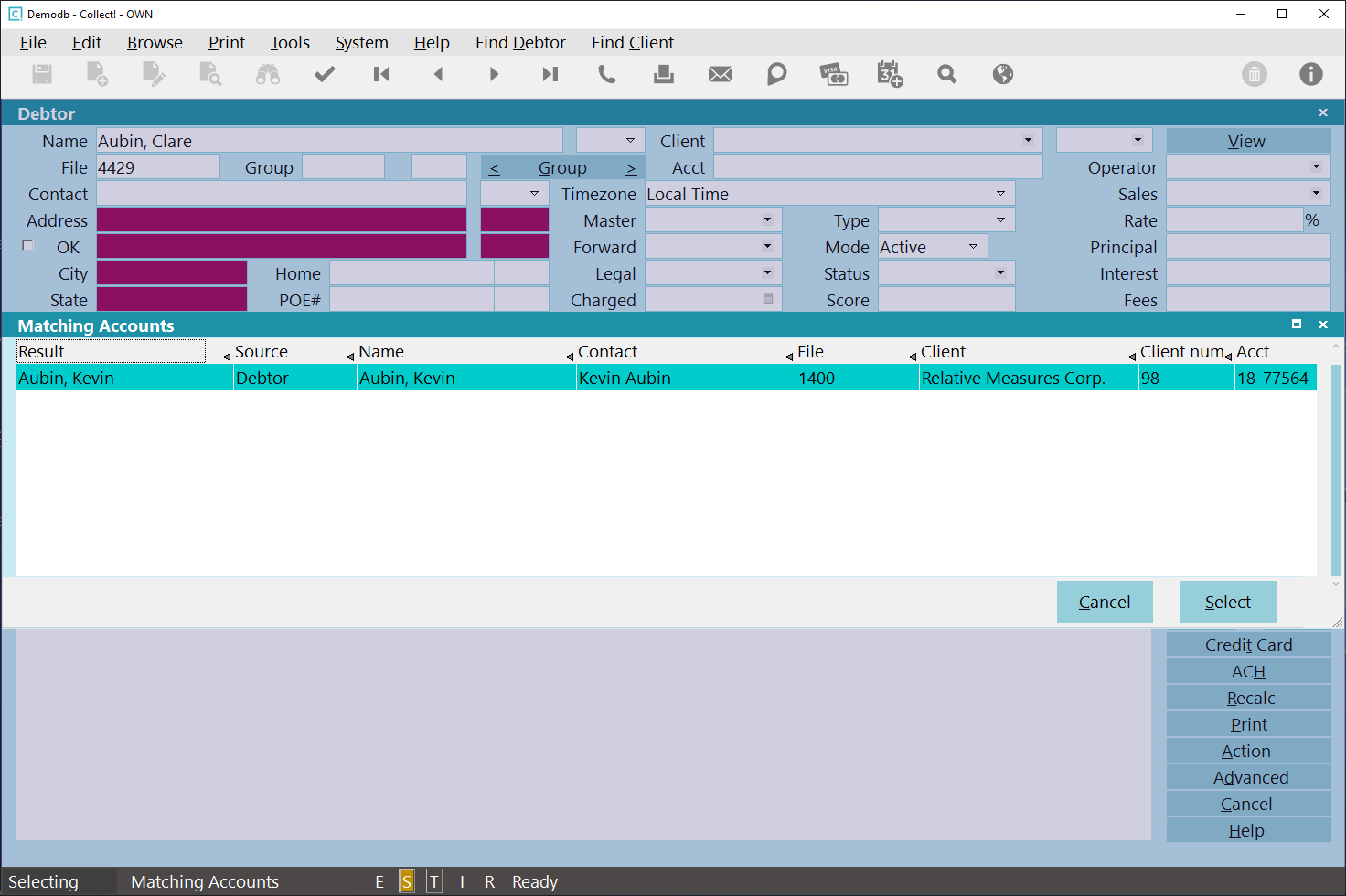
Selecting Group Accounts Together
If it is decided that the new account is the same debtor as another existing account, then clicking
Select will add this new debtor to the existing one or more accounts for the same person.

Debtor Group Button Highlighted
If it is decided it is not the same debtor, click the Cancel button instead on the Matching Accounts
popup and continue to data enter into the next field as normal.
 Every field you turn ON under the "Check" category of Setup increases the time it takes to
manually enter the data on a new account because for every field you enter, it will run a
comparison on the database and create the popup of near matches. Sites with large databases
may prefer to do all grouping via batch and none by this method.
Every field you turn ON under the "Check" category of Setup increases the time it takes to
manually enter the data on a new account because for every field you enter, it will run a
comparison on the database and create the popup of near matches. Sites with large databases
may prefer to do all grouping via batch and none by this method.

Account Matching Using Batch Processing
For this capability to function, you must have selected one or more fields under the category
"Advanced Match Conditions" in settings already entered into your "System\Preferences\Plans and
Reference Tables\ Account Matching Setup" window.
The automated matching process can take a tagged list of accounts and with both time efficiency
and accuracy, decision which accounts if any should be grouped with other debtor accounts already
in the system. Whether your entry is 25 manual accounts or thousands of Imported new accounts,
gathering them into a tagged list, then clicking "Tools\ Batch Processing" and you will see the
following:

Selecting Batch Processing
Click the radio button beside "Group accounts together".

Selecting Group Accounts Together
You will see the following popup:
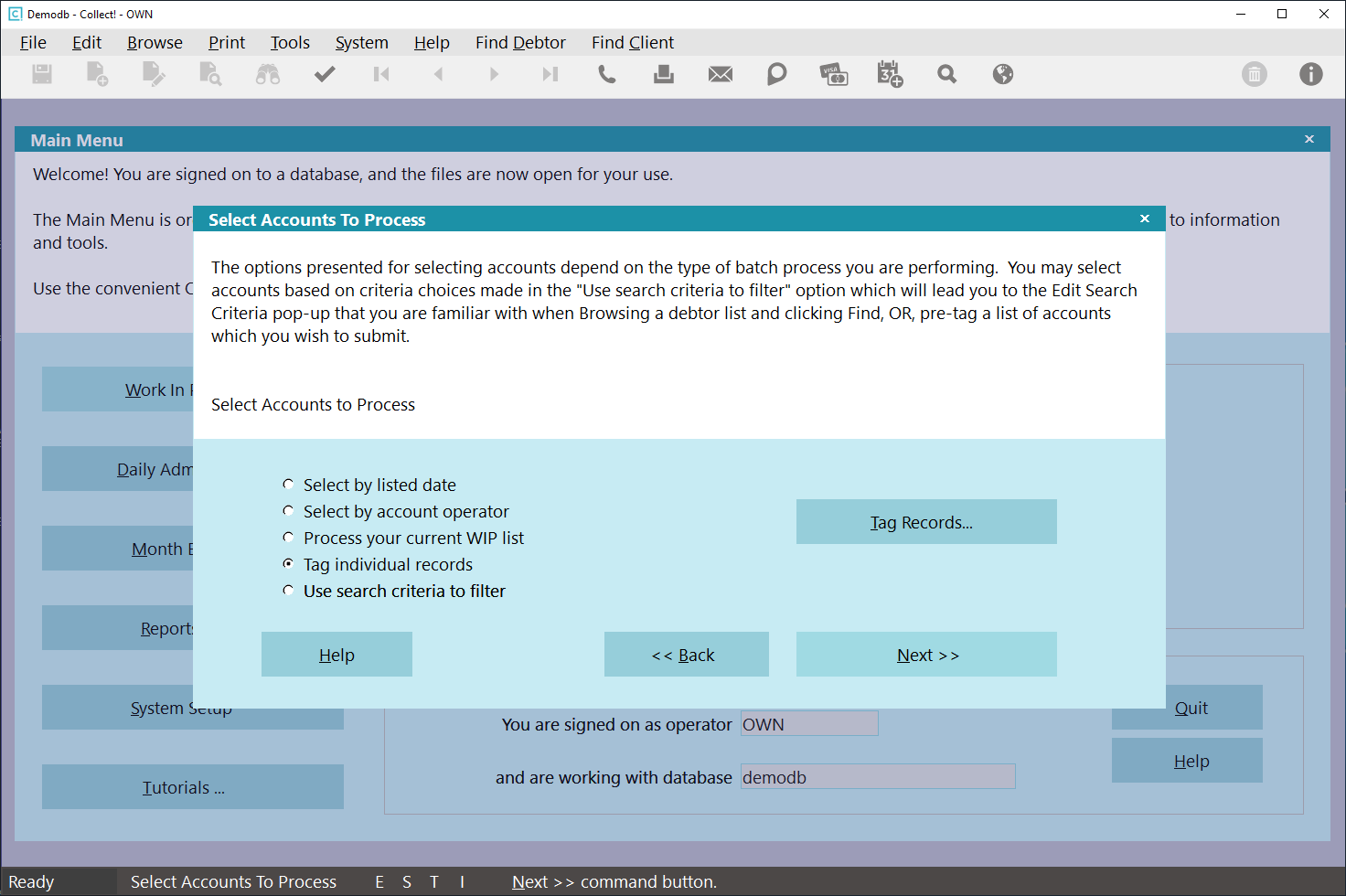
Selecting Tag Individual Records
Click the Next>> button as your tagged list will already be acknowledged by the system.
You have been advanced to a popup displaying all your existing Account Matching criteria. This is a
fail-safe to ensure that before running the process against the entire database, that the criteria
to be used has been verified. Each site can have their own individual settings. The following popup
is the shipping default settings and are represented here as SAMPLE ONLY:
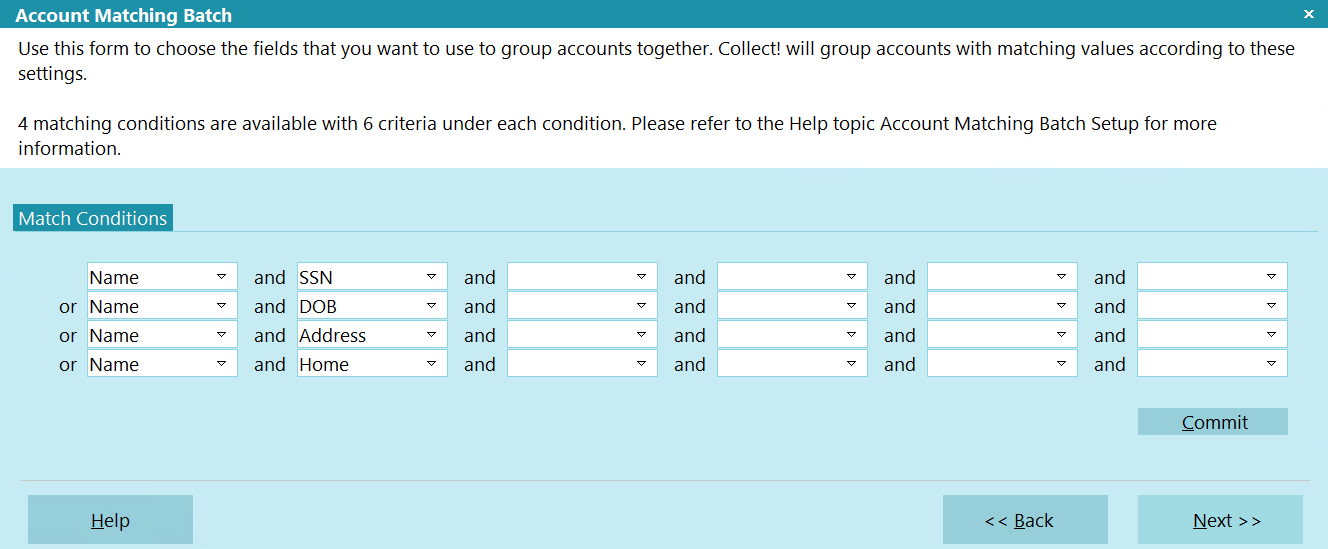
Criteria for Matching Tagged Accounts
If you do need to modify anything, you do so by selecting the field and choosing the hyphen "-" to
remove a field from the list.
When you have completed verifying your Match Condition settings, click the Next>> button.

Run Account Matching Batch
Now click the Start button. The process will run and you will receive a popup concluding that it
was completed successfully and how may records it surveyed for matching conditions:
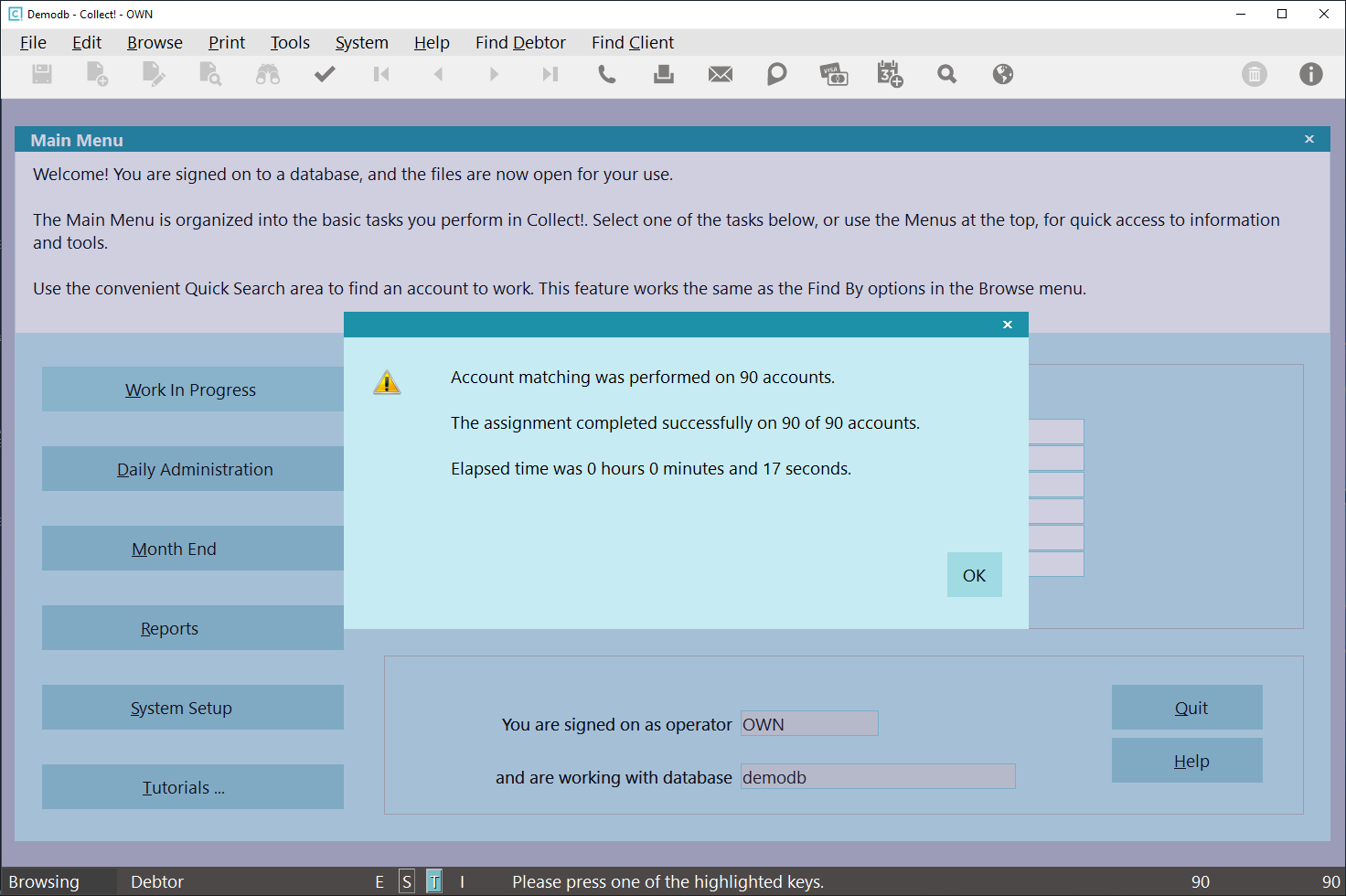
Account Matching Batch Results
Click the OK button to acknowledge and return to the Batch Processing menu. Click the Close button
in the lower right of the screen to exit Batch Processing.
If you view one of your newly grouped accounts, you will notice that the "Group" fields immediately
to the right of the File Number are now populated with numbers for for the Group # (system generated)
and Group Member # (this accounts sequence number of all the accounts linked in the Group). You will
also notice that the Group indicator has turned yellow, as have the < and > toggle keys to either
side of the Group button. Additionally, you will see the Group Tab in the lower portion of the
screen has also changed to a yellow color, indicating that there is now information in that sub-file.

Debtor Group Button Highlighted
Click the Group Tab to view the list of Group Members.

Matching Accounts/Group Members
If you have data entered several batches throughout the day, either manually or via import, you can
do a single batch grouping by gathering all the accounts listed on today's date from a Browse Active
Debtor list. Click the Find button, then enter the From/To date range (can be same day in both) in
the field called "#Listed", then click the Search button in the lower right corner of the window.
This will create a tagged list for you. You would then close the Browse Debtor list you were working
with and go into the Tools\Batch Processing menu to proceed with the Grouping accounts together.
If you input new accounts via an electronic Import of data, then you already have the convenience
of a Tagged List ready for Batch Processes such as Contact Plans, Group accounts together, and
Assign accounts to operators, without having to take the step of Browsing Active Debtors, then
creating the Tagged List with Find/ Search criteria.
It is per site preference whether you wish to run Batch Processes on your new accounts as they are
input as a complete client's listing for the day OR whether you wish to do all your new account
entry for all clients for the day followed by a single pass through batch processes using "Browse\
Active Debtors", then click the Find tile at the top of the screen, using the Edit Search Criteria
From/To #Listed date to tag a composite list of all new accounts.
 If you will be utilizing account matching and you are a new Collect! user, you may wish to
run your entire debtor list as a group process if your installer hasn't already done that
for you during conversion.
If you will be utilizing account matching and you are a new Collect! user, you may wish to
run your entire debtor list as a group process if your installer hasn't already done that
for you during conversion.
To do this, start from a Browse Debtor list - use All if you want to include Closed Mode in the
grouping for historical purposes or use an Active Debtor list only for this bulk initial group.
Press the keyboard keys Ctrl+A together OR click Edit, then Select All from the menu drop-down.
This will highlight and Tag all the debtors in the list. Follow the steps above to run the grouping
process against the whole of your database.

Account Matching By Manual Grouping
This type of grouping is done while on the Debtor screen. Click the button labeled Group to start a
process of prompts and lists for you to step through to create a new group or add the Debtor account
you are on to an existing group.
When you use this method, the new debtor's Group Member information is set to the values existing
in the Account Matching Setup window.
First, let's find the first Debtor that you would like to put in your group.
- Pull down the Browse menu and choose Find By Name. You will be presented with a form where
you can type in a name for Collect! to find in your list of Debtors.
 Type in a name just as it appears in the Debtor form, that is: "Last Name, comma, First Name"
It is not necessary to capitalize the letters. You can also look for near matches. Please
read the instructions in the Find By box or look up Find By in the Help index.
Type in a name just as it appears in the Debtor form, that is: "Last Name, comma, First Name"
It is not necessary to capitalize the letters. You can also look for near matches. Please
read the instructions in the Find By box or look up Find By in the Help index.
- When you have entered a name for Collect! to find, select OK. The Debtor form for that name
will open on your screen, if Collect! finds it.
- Let's assume the system has found the name and proceed. Now that you are looking at the Debtor
form, notice the 'GROUP' button near the top of the form, in the center. It has an arrow on
either side of it.
 If the Debtor you chose is already in a group, this button will be yellow and the arrows will be yellow.
You can press the Group button to see all members in the group or press the arrows to see the Debtor
form for each member at a time.
If the Debtor you chose is already in a group, this button will be yellow and the arrows will be yellow.
You can press the Group button to see all members in the group or press the arrows to see the Debtor
form for each member at a time.
- Press the Group button. If the Debtor is not already in a group, you will be prompted to form
a new group.
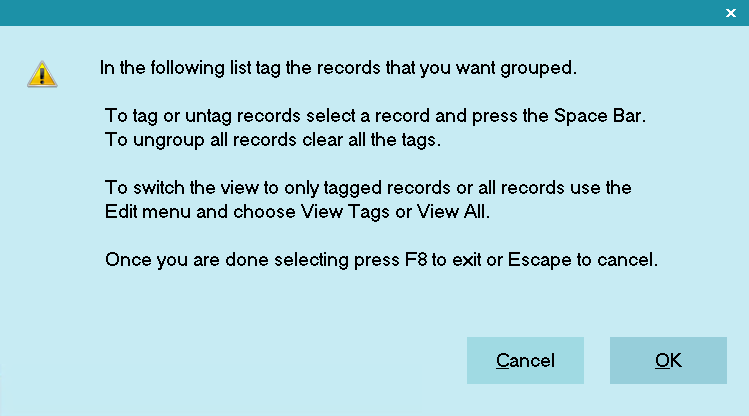
Prompt To Select Debtors To Group
- Read the instructions carefully and select OK. The list of all debtors will open and your
first choice is already highlighted in yellow. This means it is selected.
- Now use the arrow keys to find other records you want to group. When you find one and it is
highlighted, (it is black) press the spacebar and it turns yellow. Now it is selected too.
- Carry on until you have selected all your debtors for the group this way. After they are
selected, they show blue when you move off that line in the list.

Selected Debtors for New Group
 Look in the last column of the list of debtors. Notice that this particular list has a number
5 there for some records. This means they are in a group. This column shows a number when
a debtor is in a group. Collect! gives each new group a a different number. When you are
finished with this exercise, your group will have a number too.
Look in the last column of the list of debtors. Notice that this particular list has a number
5 there for some records. This means they are in a group. This column shows a number when
a debtor is in a group. Collect! gives each new group a a different number. When you are
finished with this exercise, your group will have a number too.
- Now that all of your debtors are selected, Press F8.
If none of the debtors that you selected are currently in a group, Collect! prompts you to create
a new group.

Prompt to Form a New Group
If you have Account Matching enabled, Collect! may ask you if you want to copy information, depending
on your Account Matching Setup.
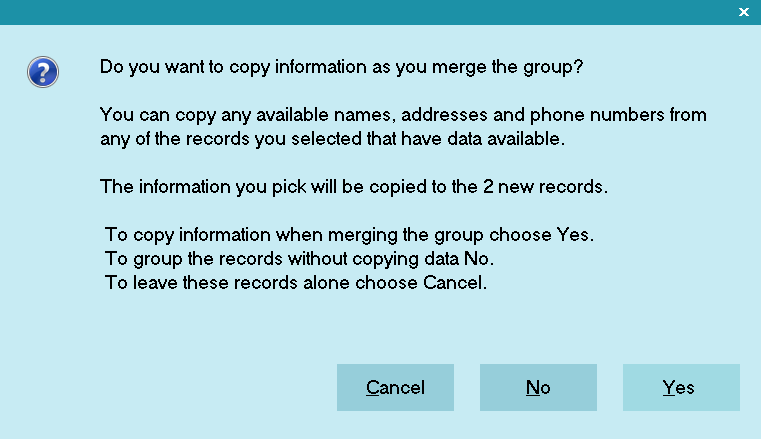
Prompt to Copy Information in New Members
If some of the debtors that you selected are currently in a group, Collect! prompts you to join them
to an existing group.
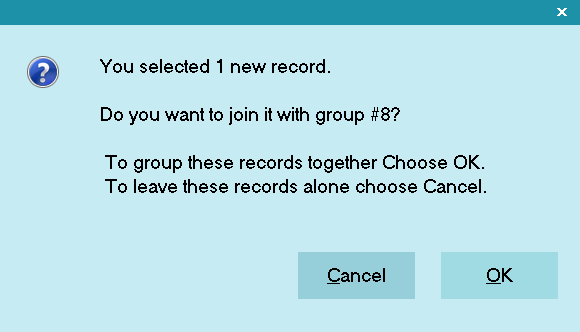
Prompt to Join To an Existing Group
- Select OK to proceed with grouping the accounts.
- You are returned to the Debtor form and now the Group button is highlighted and the arrows on
either side of it are too.

Debtor with Group Information
Also, there is a Group Number in the Group box (in the case above, it is ' 7') and the current Debtor
has a Group Member Number (in the case above, it is '1'). You can select the arrows to see the other
accounts in this group. Notice that each of them has the same Group Number but a different Group
Member Number.
- Click on the Group tab. This shows all of the members in the group in the Matching Accounts
list. Group financial totals are also displayed. Press F1 to see help on this form.
From the Matching Accounts form you can edit the group or its individual members, or run a contact
plan across the group.

Adding Members To A Group
If you choose to group a Debtor who already belongs to a group, the Group button will be highlighted
in yellow when you first view the Debtor's record. If you press the Group button, as you have just
done, you will see the Matching Accounts form.
Press Edit Group and follow the instructions displayed on the screen. The steps outlined above should
be followed for selecting additional debtors for your group.

Account Matching
When you enter a new Debtor, Collect! can automatically find matching accounts based on criteria you
choose. The Group Member Setup button that you see in the Matching Accounts form is a way of fine
tuning your Account Matching routines.
 However, Account Matching MUST be set up by administrative staff prior to grouping debtors
or editing matching criteria in the Matching Accounts form. Setup is performed through the
Account Matching Setup accessed from the Options pull down menu, Preferences. Choose Plans
and Reference Tables.
However, Account Matching MUST be set up by administrative staff prior to grouping debtors
or editing matching criteria in the Matching Accounts form. Setup is performed through the
Account Matching Setup accessed from the Options pull down menu, Preferences. Choose Plans
and Reference Tables.

| 
Was this page helpful? Do you have any comments on this document? Can we make it better? If so how may we improve this page.
Please click this link to send us your comments: helpinfo@collect.org